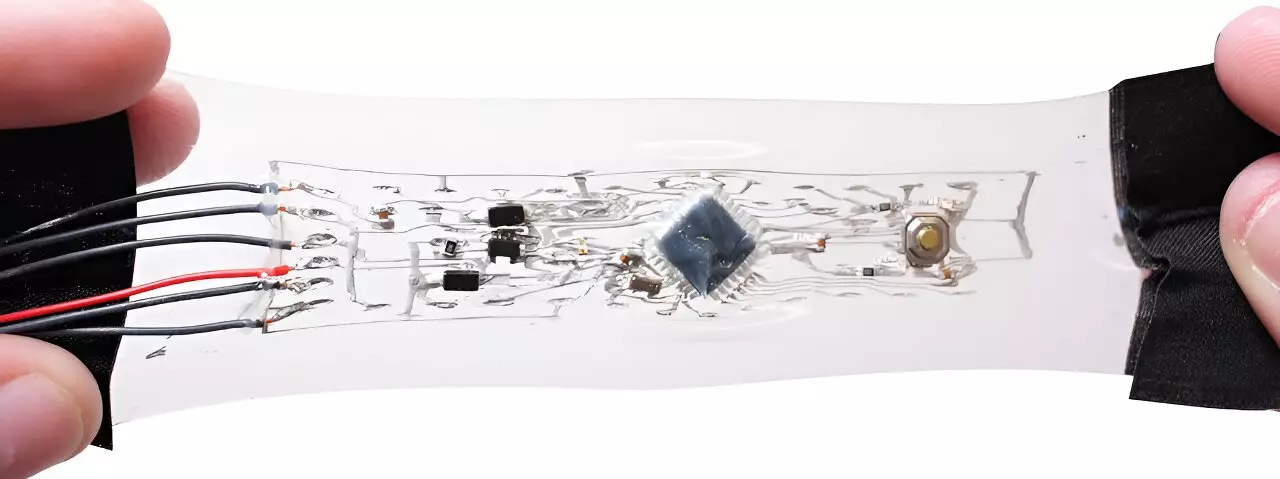Soft robotics is an emerging field that intertwines with numerous sectors ranging from healthcare to search-and-rescue missions. The integration of soft robots and wearable electronics presents unique challenges, particularly in ensuring these devices are functional while maintaining flexibility and resilience. Without a doubt, the need for advanced electronics capable of stretching without compromising performance has kept researchers engaged in relentless innovation. Among them is Prof. Rebecca Kramer-Bottiglio and her team, whose transformative work is poised to change the landscape of soft robotics fundamentally.
One of the persistent hurdles in soft robotics lies in the interplay between soft materials and rigid electronic components. Designers have traditionally faced a dilemma: how to incorporate intricate circuitry into soft bodies without overwhelming them with rigidity. Most existing solutions involve pairing soft robots with external microcontrollers, diminishing their operational efficiency. To address this profound issue, the researchers have pioneered soft versions of Arduino components, commonly used in electronic prototyping. These stretchable Arduinos enable seamless integration within soft robotic bodies, allowing the devices to function effectively while remaining pliable.
Notably, the scale at which this circuitry can stretch is unprecedented—enabling elongation beyond three to four times their original dimensions. This breakthrough marks a pivotal transition from rudimentary prototypes to sophisticated multilayer circuits, thus enhancing the scope and reliability of future applications in soft robotics.
Kramer-Bottiglio’s lab has significantly advanced the manufacturing landscape for stretchable electronics. The team employed gallium-based liquid metal and transformed it into a paste-like substance through exposure to oxygen. This innovative preparation allowed for easier application onto soft substrates and rigid electrical components. The use of laser-cut paper masks allowed for precise patterning, giving researchers a reliable method of constructing intricate layouts while ensuring strong adhesion.
Importantly, the open-sourced nature of their materials and techniques invites collaboration and innovation from practitioners around the globe. The clear sharing of their processes via platforms like GitHub is not only commendable, but it also sets a precedent in fostering community-driven advancement in the field.
The implications of such advancements are staggering. In soft robotics, the team successfully embedded stretchable electronics into various soft robots. For instance, they developed applications for a quadruped robot that controls its gait while adapting to its morphing structure seamlessly. This adaptability showcases the agility of the new electronics, highlighting a move away from functionality that is limited by static designs.
The potential applications extend beyond robotics into the domain of wearable technology. Kramer-Bottiglio’s research team demonstrated the electronics’ use in rehabilitation devices, particularly focusing on the elbow—a notoriously complicated site for wearable applications. The ability to integrate stretchable circuits means that devices can now conform to dynamic movements, representing a significant leap forward for therapeutic technologies.
Implications for Future Research
While the team’s findings are exciting, they also raise intriguing questions about the future of soft robotics. As these devices become more prevalent in practical applications ranging from healthcare to complex robotics, understanding the long-term effects on sustainability and usability becomes paramount. Will the dominant extraction methods for the raw materials remain viable? The ethical considerations of deploying soft robotics will need significant attention as their capabilities extend into sensitive realms like patient care.
Moreover, researchers purchasing into this technological development must consider the robustness of their creations. By embedding electronics in high-strain locations—as demonstrated by Kramer-Bottiglio’s team—future designers might strive for an even delicate balance between agility and performance reliability.
As we inch closer to an era where soft robotics can operate autonomously, the innovations stemming from Kramer-Bottiglio’s lab serve as a lighthouse for aspiring engineers. Their pioneering stretchable electronics signal the dawn of a new chapter in the integration of technology and flexibility. Not only do such developments promise an expansive suite of applications, but they also help redefine our understanding of what robotics can achieve.
The combination of soft robotics and wearable technology is heralding a transformative shift. With these advanced stretchable electronics, we are not merely on the brink of new discoveries; we are transitioning into a landscape where function and flexibility intersect smartly, thus paving the way for versatile and practical solutions that extend far beyond the laboratory.


Leave a Reply